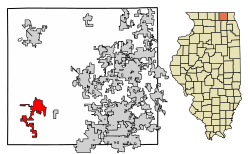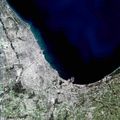2000 Census
As of the census [24] of 2000, there were 6,355 people, 2,387 households, and 1,694 families residing in the city. The population density was 1,598.5 inhabitants per square mile (617.2/km2). There were 2,475 housing units at an average density of 622.6 per square mile (240.4/km2). The racial makeup of the city was 92.07% White, 0.30% African American, 0.27% Native American, 0.28% Asian, 0.02% Pacific Islander, 5.54% of other races, and 1.53% of two or more races. Hispanic or Latino of any race were 13.00% of the population.
There were 2,387 households, out of which 38.6% had children under the age of 18 living with them, 55.9% were married couples living together, 10.7% had a female householder with no husband present, and 29.0% were non-families. 24.9% of all households were made up of individuals, and 9.8% had someone living alone who was 65 years of age or older. The average household size was 2.64 and the average family size was 3.17.
The population was spread out, with 29.3% under the age of 18, 8.6% from 18 to 24, 31.0% from 25 to 44, 19.2% from 45 to 64, and 12.0% who were 65 years of age or older. The median age was 34 years. For every 100 females, there were 96.3 males. For every 100 females age 18 and over, there were 94.3 males.
The median income for a household in the city was $50,214, and the median income for a family was $57,209. Males had a median income of $41,298 versus $26,317 for females. The per capita income for the city was $22,225. About 3.9% of families and 4.4% of the population were below the poverty line, including 5.4% of those under age 18 and 5.5% of those age 65 or over.
Historical population| Census | Pop. | Note | %± |
|---|
| 1860 | 1,119 | | — |
|---|
| 1870 | 1,327 | | 18.6% |
|---|
| 1880 | 1,264 | | −4.7% |
|---|
| 1890 | 1,445 | | 14.3% |
|---|
| 1900 | 2,005 | | 38.8% |
|---|
| 1910 | 1,936 | | −3.4% |
|---|
| 1920 | 1,758 | | −9.2% |
|---|
| 1930 | 1,948 | | 10.8% |
|---|
| 1940 | 2,034 | | 4.4% |
|---|
| 1950 | 2,726 | | 34.0% |
|---|
| 1960 | 3,568 | | 30.9% |
|---|
| 1970 | 4,235 | | 18.7% |
|---|
| 1980 | 4,361 | | 3.0% |
|---|
| 1990 | 4,768 | | 9.3% |
|---|
| 2000 | 6,355 | | 33.3% |
|---|
| 2010 | 7,648 | | 20.3% |
|---|
| 2020 | 7,568 | | −1.0% |
|---|
|
Marengo city, Illinois – Racial and ethnic composition
Note: the US Census treats Hispanic/Latino as an ethnic category. This table excludes Latinos from the racial categories and assigns them to a separate category. Hispanics/Latinos may be of any race.| Race / Ethnicity (NH = Non-Hispanic) | Pop 2000 [28] | Pop 2010 [26] | Pop 2020 [27] | % 2000 | % 2010 | % 2020 |
|---|
| White alone (NH) | 5,441 | 6,305 | 5,758 | 85.62% | 82.44% | 76.08% |
| Black or African American alone (NH) | 16 | 41 | 94 | 0.25% | 0.54% | 1.24% |
| Native American or Alaska Native alone (NH) | 12 | 16 | 20 | 0.19% | 0.21% | 0.26% |
| Asian alone (NH) | 18 | 37 | 51 | 0.28% | 0.48% | 0.67% |
| Pacific Islander alone (NH) | 0 | 1 | 0 | 0.00% | 0.01% | 0.00% |
| Other race alone (NH) | 0 | 7 | 16 | 0.00% | 0.09% | 0.21% |
| Mixed race or Multiracial (NH) | 42 | 69 | 248 | 0.66% | 0.90% | 3.28% |
| Hispanic or Latino (any race) | 826 | 1,172 | 1,381 | 13.00% | 15.32% | 18.25% |
| Total | 6,355 | 7,648 | 7,568 | 100.00% | 100.00% | 100.00% |





